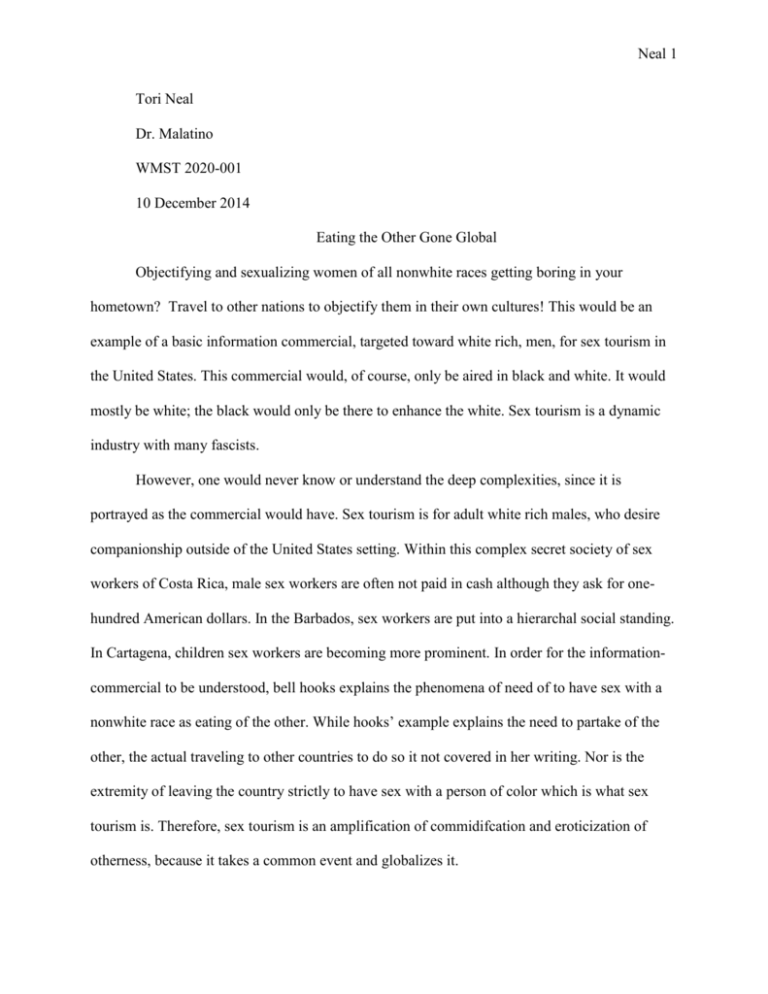
Neal 1
Tori Neal
Dr. Malatino
WMST 2020-001
10 December 2014
Eating the Other Gone Global
Objectifying and sexualizing women of all nonwhite races getting boring in your
hometown? Travel to other nations to objectify them in their own cultures! This would be an
example of a basic information commercial, targeted toward white rich, men, for sex tourism in
the United States. This commercial would, of course, only be aired in black and white. It would
mostly be white; the black would only be there to enhance the white. Sex tourism is a dynamic
industry with many fascists.
However, one would never know or understand the deep complexities, since it is
portrayed as the commercial would have. Sex tourism is for adult white rich males, who desire
companionship outside of the United States setting. Within this complex secret society of sex
workers of Costa Rica, male sex workers are often not paid in cash although they ask for onehundred American dollars. In the Barbados, sex workers are put into a hierarchal social standing.
In Cartagena, children sex workers are becoming more prominent. In order for the informationcommercial to be understood, bell hooks explains the phenomena of need of to have sex with a
nonwhite race as eating of the other. While hooks’ example explains the need to partake of the
other, the actual traveling to other countries to do so it not covered in her writing. Nor is the
extremity of leaving the country strictly to have sex with a person of color which is what sex
tourism is. Therefore, sex tourism is an amplification of commidifcation and eroticization of
otherness, because it takes a common event and globalizes it.
Neal 2
In "Intimate Tourism Markets: Money, Gender, And The Complexity Of Erotic Exchange
In A Costa Rican Caribbean Town” Susan Frohlick explains women’s involvement in the sex
tourism industry, as customers, and the economic impact. Costa Rica is a global hot spot for sex
tourism with a variety of races participating in this economy which allows for a variety of
“tastes”. Euro- American women typically partake in eating of the other with a specific race,
Caribbean-Costa Rican men. These women also partook of the “local folk economy” which is
the phenomena of spending as little money as possible. Since everyone is poor there, so to feel
not like a tourist one must bargain and pay cheaply for the commodities. This occurrence is also
applied to sex work. Not only are these women applying this metaphor to sex tourism, but
buying sex has been described as “hunting” for the right person to buy sex from. After the
“hunting” and partaking of the “local folk economy,” sex workers are often not paid very much
and very little in cash. Sex workers are often paid in cigarettes, by paying their rent, or with
“gifts.” Frohlick closes by stating the obvious; sex work is an unequal exchange (Fohlick).
In “Sex Tourism Booming,” by IRIN it explains the sex tourism industry in Cartagena.
As one walks into the city, there is a group of sex workers lingering just outside waiting for the
foot traffic. Within the ten years, the industry has only grown with more workers and younger
ones. This is partly due to the rush of wealthy tourists and the poverty stricken locals. Poverty is
so rampant that over five-hundred children are involved in sex tourism, and it is speculated that
many of them were forced to do so by their family members. Many children then become
addicted to drugs or alcohol which is used as a tool to keep them in the sex trade. Programs are
in place to try and help these children escape sex work; however, being in a program does not
guarantee that a child will stop doing sex tourism. The children simply “don’t think of
themselves as victims.” Another problem children sex workers face is the lack of condoms
Neal 3
which leads to rampant HIV. This lack of condoms is also due to the myths surrounding sex with
children such children obviously being “safe” to have sex with or myths about cleaning the
genitals after sex (IRIN).
In "Female Sex Tourism In Barbados: A Postcolonial Perspective” Joan Philips explains
the interworking of sex tourism in the Barbados. When the phrase “sex tourism” is said one will
usually think of a white cisgender-heterosexual hypermasculine tourist looking for sand and sex.
However, the less common imagery is the kind that was created in the 1960s of women in their
late thirties pursuing the same experience of the other, and even less common is the experience
of the male sex worker. In the Barbados, male sex workers are divvied into a three tier hierarchy
of sex tourism success. On the bottom rung, are the “rough and ready” boys, who are young and
inexperienced. While they may obtain a few gifts from tourists, they make very little cash and
are generally unsuccessful. They remain under the false assumption that every tourist is rich. Just
about the “rough and ready” beach boys are the “middle-ranking” boys. These sex workers are
little older and generally have a European partner who stays with them for a portion of the year
while usually managing some type of water sports club. Their payment is often in cash or
expensive gifts such as cars or high end name brand objects. On the top of the hierarchy, is the
“old veteran.” He is much older with graying hair. He will usually own many businesses that
give the lower tier sex workers jobs and opportunities to be in contact with female tourists. He
will be married to a European woman, and will divide his time between living there and in her
country. He will also know at least one European language, if not more. He is also allowed to
dress more conservatively, since he is economically stable ( Philips ).
The sex tourism dynamics in the Barbados mirror the hierarchy in the United States. Sex
workers are placed into a hierarchy of finical success, and white boys are placed into a hierarchy
Neal 4
of success based on how many times they have partaken of the other. The “rough and ready”
white boys would be boys a few months out of high school eager to eat of the other. The
“middle-ranking” boys would be the college students who are making lists of which race to
conquer. Finally, the “old veteran” would be the old rich man, who had not only ate of the other
within the United States, but traveled into the world to conquer people in their own land
(Philips). Reaching the final tier of the hierarchy only occurs after hard work on partaking of the
other, and is the goal of everybody in a hierarchy: reach the top.
Not only does one have to inducted into the top tier of the hierarchy, one must reach it in
the correct manner. For example, in Costa Rica one must partake of the “local folk economy”
and “hunt” for the correct sex worker. It is expected for the customer to pay as little as possible
and to bargain to get it, because the whole country must be poor, thus, everything, even sex,
should be cheap. One must simply “hunt for the correct deal ( Frohlick). The other is literally
turned into a commodity. Sex workers are things to be bought and found. The only way to
ascend to the top of the hierarchy is to accept this concept. Otherwise, sex tourism seems
barbaric.
There is such great need for eating the other to occur that child sex workers are working
on a regular basis. Rich tourists that need to partake of the other in order to ascend to the next
tier of the hierarchy will pay for sex with children (IRIN). This phoneme happens partly because
of the myths surrounding having sex with children. For example, some people believe that one
cannot get STIs from children. Thus, there is no need for a condom and there is no need to worry
about their sexual health. This also happens do to the “need” to partake of the other. Child sex
tourism is doing well, because commidifcatoin and eroticization of the other is doing well.
Neal 5
Sex tourism is the next step of commidifcatoin and eroticization of the other. In the
hook’s example of commidifcation and eroticization of the other of the white, rich college
students the example ended after their list, of races they needed to conquer ended. However, if
the example was to continue into the boy’s adulthood, it would follow their journey into
partaking in sex tourism. Sex tourism is the drive to eat the other within the United States and
taking it global. It is the next step. Instead of the college boys trying to have sex with the internal
exchange student before graduation, they will go to their desired country and conquer the women
there during their vacation (hooks). Sex tourism is to eat the other on a transnational stage.
In order to reach the final tier of the partaking of the other hierarchy, one must conquer
nonwhite races outside of the United States. This is most easily done through sex tourism. With
commidifcatoin steadily happening in the United States, it is easy for a white, rich tourist to
simply buy their need to partake of other. If the sex worker is just a commodity who is there to
fulfill the need of sexual dominance, then it is unproblematic to buy one’s way to the top of the
problematic hierarchy. Conquering nonwhite races within their territory fulfils their colonizer
nostalgia complex, while promoting them to this sick status of “old veteran” (hooks; Philips).
Buying objects to obtain a higher social status is common practice in high society. Thus, one
must travel outside of the United States and buy people, as if they were food, in order to eat the
other, to reach the final tier of the almighty colonizer.
While commidifcation and eroticization of otherness may continue to be a rite of passage
for rich white men, the information-commercial may now be in color. There are now shades of
gray and multi-colors. Commidification and eroticization of otherness occurs due to this deep
need to eat of the other. However, sex tourism takes this colonizer complex, and brings it back to
Neal 6
the idea of sexually conquering and dominating the world. It makes the upheld norm of
commidfying and eroticizing women of color bodies and goes global.
Neal 7
Works Cited Page
Frohlick, Susan. "Intimate Tourism Markets: Money, Gender, And The Complexity Of Erotic
Exchange In A Costa Rican Caribbean Town." Anthropological Quarterly 1 (2013):
133. Project MUSE. Web. 4 Dec. 2014.
hooks, bell. “Eating the Other: Desire and Resistance.” Black Looks: Race and Representation.
Boston: South End Press, 1992. 21-39.
IRIN. “Sex Tourism Booming.”Women Worldwide: Transnational Feminist Perspectives on
Women. Eds. Janet Lee and Susan Shaw. New York: McGraw-Hill, 2011. ISBN #
9780073512297.
Phillips, Joan . "Female Sex Tourism In Barbados: A Postcolonial Perspective." Brown Journal
Of World Affairs 14.2 (2008): 201-212. OmniFile Full Text Mega (H.W. Wilson). Web.
10 Dec. 2014.







